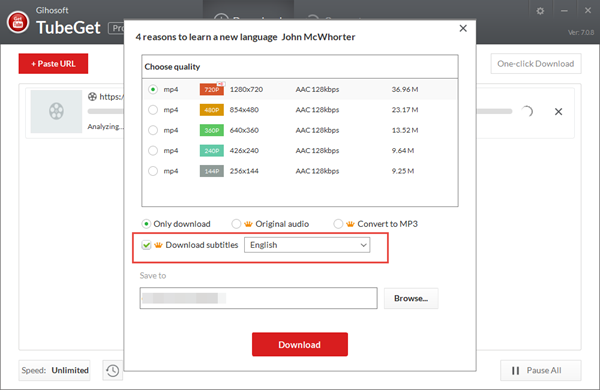


Next, click the “Convert” button below the pasted text, and your formerly-SBV-formatted subtitles will be transformed into SRT-formatted subtitles. Simply open the SBV file you downloaded from YouTube in a text editor (e.g., Notepad, Notepad ++, TextEdit), select all of the contents (Windows/Linux: CONTROL + A, Mac: COMMAND + A) and paste it into the box below. Convert Your Subtitles using the SBV to SRT Conversion Form
#SUBTITLES ON YOUTUBE CODE#
(Alternatively, you can access the “Captions and Subtitles” menu from the video player page the link is below the “embed” code and video description.) From the menu, download to your computer (“Save As”) the subtitle file you’d like to convert from the list of available caption tracks. The first step in the conversion is to login to your YouTube account, go to the listing of your videos, and click the “captions” button in the lower portion of the video details. (Click the image to view a larger version.) The YouTube “Captions and Subtitles” menu. Download The SBV Subtitle File from YouTube
/YouTubeSubtitlesExample1-4bab21538d5442a2a681828002b5b1c9.jpg)
Fortunately, we’ve happened upon a relatively simple process by which SBV files can be converted to the commonly-used (and compatible with YouTube) SubRip (SRT) format, which we’ll outline here. The subtitle file generated by YouTube’s auto-sync process has an SBV extention, which essentially introduces a new subtitle format, and limits auto-sync-generated subtitles’ usefulness outside of YouTube applications. Of course, auto-sync is at its most efficient when a human being accurately transcribes all spoken dialog/narration in a video’s soundtrack, but the savings in time is still quite substantial.
#SUBTITLES ON YOUTUBE HOW TO#
While this tutorial isn’t focused on how to use auto sync (watch a segment from Google’s launch of the YouTube auto-accessibility features for a tutorial of sorts), it is worth pointing out the primary benefit of auto-sync: it reduces (and in some cases-shorter videos with fewer unique speakers, for instance-eliminates) the need for the traditional painstaking synchronization process that consumes the most time of any portion of the captioning process. However, it is the auto-sync feature that figures to be-at least in the short term-a real game-changer for serious CIYers. Most of the buzz surrounded the auto-caption feature based upon the speech-to-text engine that powers Google Voice, auto-caption allows individual viewers to access a machine-generated transcription of a video’s speech content, which is then automatically synchronized with the video’s sound track and displayed as individual captions. “ We’ve also obtained special pricing and benefits from additional third party vendors, who can assist with caption, translation, and subtitle needs,” the company adds.One of the most intriguing CIY-related developments in captioning has been Google’s automatic accessibility features for YouTube channels. While the company says these tools should suffice, it’s also providing creators who used Community Contributions in the past two months with six-month subscriptions to captioning service Amara.
#SUBTITLES ON YOUTUBE MANUAL#
Instead, creators will now have to rely on Google’s built-in automatic captions, as well as manual captions and subtitles. “ If you have contributions currently saved as drafts, these will be available for the next 60 days (until Sept 28 2020), and you have until then to publish them before they’re removed,” the spokesperson said. Even better, creators will have a chance to approve already submitted contributions until September 28. The good thing is that community-contributed captions that have already been posted will continue to show up even after the removal.


 0 kommentar(er)
0 kommentar(er)
